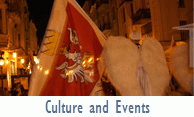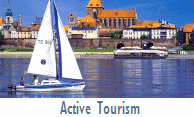|
Ratusz Staromiejski (Muzeum Okręgowe)
Address:
Toruń, Rynek Staromiejski 1 (1 Old Town Market Square)
Opening hours:
High season (May - September): Tue - Sun: 10am - 6pm | Mon: closed
Low season (October - April): Tue - Sun: 10am - 4pm | Mon: closed
Admission fees (without reservation charge):
Old City Town Hall: 11 PLN, reduced: 7 PLN
Old City Town Hall Tower: 11 PLN, reduced: 7 PLN
Old City Town Hall + Town Hall Tower: 17 PLN, reduced: 12 PLN
Booking guides, entrance tickets, further details:
Toruński Serwis Turystyczny (Toruń Tourist Service), tel. (+48) 66 00 61 352, e-mail: muzeum@turystyka.torun.pl
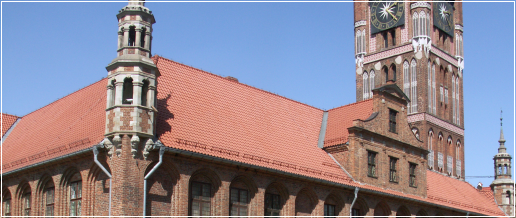 • About the Town Hall edifice see here.
The District Museum in Toruń is the oldest and the greatest museum in Toruń and one of the oldest and the greatest in Poland. Its origins date back to the year 1861 when the German Städtisches Museum in Thorn (Municipal Museum in Toruń) was established; on the other hand in 1876 Polish Science Society of Toruń founded another museum. It was only 1930 when these two were combined into one Municipal Museum. The first exhibits were among others: archaeological artefact and the elements of old Toruń art. Whereas the very first museum collections in Toruń existed at the Academic Gymnasium in the end of 16th century. They were the peculiarity: odd shells, skeletons, cinerary urns excavated in the vicinity, old mathematical and astronomical instruments, globes, etc. Permanent exhibitions:
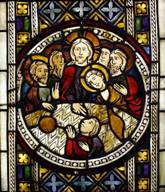 Gothic Art Gallery Gothic Art Gallery The Gallery of Gothic art is located on the ground floor, where formerly stalls and bakers' stands were placed. The gallery consists of sculptures, and sacral paintings from the half of the 14th to the beginning of the 16th century, which represent the main motifs of the mediaeval art. The exhibits come from the area of Eastern Pomerania region and from Silesia (also connected with Toruń, as the most significant artistic centre of the Teutonic state).
The exhibition includes as well stained glass works of exceptional beauty and value, which were made by the local masters. This collection is unique on a wide scale. i 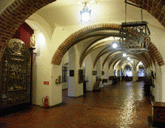 Ancient Toruń. History and the art handicraft 1233-1793 Ancient Toruń. History and the art handicraft 1233-1793 This permanent exhibition is also on the ground floor, in the gothic interiors of the former cloth halls. The exhibition aims at presenting the history of Toruń from the location of Toruń Old (1233) and Toruń New Town (1264) to the 18th century, with the focus on the work of Toruń craftsmen. There are numerous examples of craft work from both the mediaeval and modern times, Guild memorabilia, pieces and details of architecture, weaponry and arms, wood-carvers' and painters' works, as well as the works of Toruń famous goldsmiths. The exhibition is complemented by the display of modern Toruń sacral art, placed in the room on the first floor of the Town Hall. i In the medieval Weighing Machine Room the permanent exhibition on Toruń mints and coins is held. It presents the history of Toruń mints from the Teutonic Knights' times, up to 1766, when during the times of the last Polish king, Stanisław August Poniatowski, the town authorities were made to close down the mint. Apart from the products of the mints the exhibition presents also selected documents. These are e.g. the facsimile of privilege from 1457, the information about the location of the mint buildings in the beginning of the 15th century, the bills of mints from the years 1462-1519, the information about the managers of the mint and the workers, the information of the whereabouts of striking coins commemorating special events, and the letter of Stanisław August finishing the work of the mint. The objects of extreme rarity that deserve particular attention are the samples of silver metal plate for making coins, with the certificate of the commission checking its quality, which are a part of the collection of the State Archives in Toruń. i 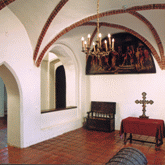 Medieval Judical Hall Medieval Judical Hall Judicial Hall is the only medieval singularity in Poland and with its back panel provides a rare example of medieval court premises. Exhibits included here relate to the history of the Toruń's judiciary from the 14th century to 1793. The former equipment are also images of pre-1605 years: 'Judgement of Susannah', 'Cambyses Judgement' and image showing the trial in this room. On the table a valuable court crucifix from the 14th century, for the oath. On the west wall portrait of the mayor Johann Gottfried Roesner, beheaded as a result of the judical sentence which found guilty for the Toruń Tumult in year 1724. i  The Grand Hall and the Toruń's Patricians Portraits The Grand Hall and the Toruń's Patricians Portraits On the first floor of the Town Hall, in the Grand Hall, the Gallery Toruń's Patricians Portrait from the 16th to the 18th century is located. There are the portraits of people of special importance for Toruń e.g. Nicolaus Copernicus, Heinrich Stroband (the mayor of Toruń for 22 years), Simon Weiss (the town physician).
This is the only in Poland in such a quantity of objects preserved bourgeois portraits collection. At the same time, the collection is the best representative of Toruń painting. Among the portraits there are excellent works which authors - the students or imitators - created following the eminent Renaissance art masters such as Albrecht Dürer, Lucas Cranach.
The adjoining hall is devoted to historical paintings. A giant composition showing The second Treaty of Toruń by Marian Jaroczyński is especially eye-catching. i 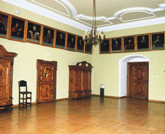 The Royal Room and the Polish King's Portraits The Royal Room and the Polish King's Portraits In The Royal Hall, which is placed on the first floor as well, The series of portraits of Polish Kings is on display. Additionally, there are beautifully inlaid doors and furniture of Toruń famous inlay art of 18th century.
i The exhibition is a subject-based presentation of gold masterpieces from the rich collection of the District Museum in Toruń. The variety of objects, both concerning the time and the place of origin, their form and function, makes it necessary to distinguish several groups of objects according to non-homogenous criteria: first of all the criterion of function, then of the place of origin and style. The exhibition presents: guild vessels, Polish vessels and tableware, jewellery and accessories connected with outfit (including pocket watches), silverware from European workshops.
The Skrwilno treasure (>>), consisting of Renaissance and Mannerism jewellery, and silver vessels and household objects, was acquired in 1961 during the archaeological research carried out by the Toruń museum in Skrwilno in the Dobrzyń Land. The exceptional significance of this set of objects derives from the fact that it was the possession of a particular family, a household; thus the treasure becomes a kind of document, presenting the level of wealth of a representative of nobility from the central part of the country in the first half of the 17th century.
• Read more about the Skrwilno Treasure here. i 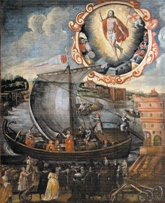 Sacral art of modern Torun 16th - 19th c. Sacral art of modern Torun 16th - 19th c. The exhibition includes works from Toruń churches - from the Catholic and Protestant (sacramental chalices, patens, censers, crucifix, epitaphs from St Mary's Church, a unique image of 'Christ's Sermon on the Boat' show, among others Toruń's quay cranes and port facilities with the panorama of the left-bank Toruń (Podgórz district), commemorative cinerary urn in honor of Mayor Rösner. The exhibits presentation in the historical context is to serve as proof of Toruń modern community consisting of different faiths.
i 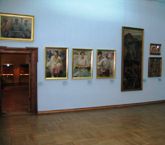 Gallery of Polish Painting mid.18th - mid. 20th c. Gallery of Polish Painting mid.18th - mid. 20th c.On this floor one can also see The Gallery of Polish paintings from the mid. of the 18th to the mid. of the 20th century, which contains the works of famous painters, e.g. Bacciarelli, Smuglewicz, the Gierymski Brothers, Witkiewicz, Malczewski, Matejko.
i .JPG) Interiors of Gothic, Renaissance, Rococo styles Interiors of Gothic, Renaissance, Rococo styles The cellars and ground floor are Gothic in style. Here one can admire exceptional, rich vaultings layout of the halls of different functions (the Cloth Hall, the so-called bread benches, City Scales, and the Judical Hall).
The first floor, Renaissance in character, was remodelled at the begining of the 17th century. It used to be occupied by the municipal authorities (the Council Hall, since the 16th century referred to as the Senate Hall, the Tribute Office, the Weta Court Office, the Chancellery, the Treasurer’s Office, and the Grand Hall). Much of that floor has been destroyed during Swedish attack in 1703, thus only a remnants of the former splendour survived.
The most richly and ornamented room was the Renaissance Council Hall (Senate). Built and equipped in 1603, unfortunately, was completely destroyed in the year 1703 and therefore has no decorations now. It was comparable with that which comes from the Great Hall of the Council (Red Room) at the Main Town Hall in Gdańsk. The Council Hall was a pride of the city, was the expression of wealth of Toruń's patriciate, adorned by chroniclers and visitors to the city, has raised admiration. i
|
| All rights reserved Toruń 2005-2009 | About us | CenterMedia |




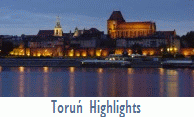
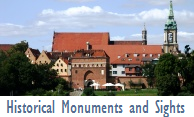
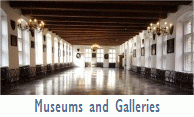
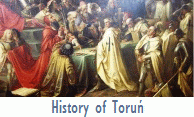
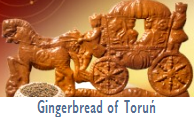
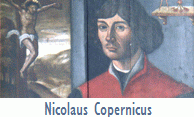
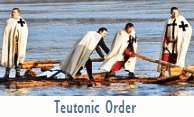

_talar___b.bmp)
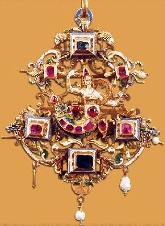
 Suggested Reading:
Suggested Reading:
